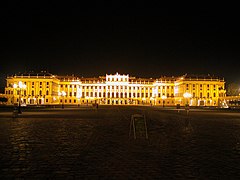Schönbrunn yellow
Schönbrunn yellow (also Habsburg yellow , imperial yellow , incorrectly Maria Theresa yellow ) is the traditional color of Austrian representative architecture of the late Baroque period . The color is an earthy reddish yellow . It corresponds to the shade of a coloring with the pigment gold ocher in lime . A nuance that is more pastel -like and adapted to the taste of the times of the late 19th century is the Seitenstetten yellow . Corresponding color designs are common as baroque yellow in the whole area from Bavaria to Bohemia , Hungary and Slovenia .
Schönbrunn yellow
color code: # F0D077
The façade coloring of magnificent Austrian buildings with the pigment gold ocher from France or Italy - in combination with rich, warm, neutral gray tones for zero surfaces - can be proven up to the Baroque period. In the 1780s, however, Emperor Joseph II decreed that all buildings of the State of Austria-Hungary and the House of Habsburg should be painted in this ocher (the name 'Maria-Theresiengelb' after his mother Maria Theresa , who died in 1780, is therefore misleading) . The French import goods - especially from the recently rediscovered ocher quarries in southern France - were exceptionally expensive, but ocher mines in Bohemia were in his possession that could meet the demand. This ordinance can be seen as a prime example of the physiocratic and mercantilistic concepts of Josephinism .
The name given to the color is the painting of the Schönbrunn Palace in Vienna. From 1817 to 1819 Johan Aman harmonized and simplified the facade in line with the classicist taste of the time. This Schönbrunn yellow is the color that was to become the trademark of the Austro-Hungarian monarchy well into the 20th century , as all train stations and government buildings, numerous castles , monasteries , churches , and - from the upper bourgeoisie , later also the peasantry - also adopted Villas , townhouses and farms were kept in it.
The original Schönbrunn yellow wall color is technically produced by first coloring lime with green iron (II) sulfate ( green salt ). By precipitation and oxidation, the typical yellow arises iron (III) oxide hydroxide (FeO (OH)), which determines the color tone. When heated, for example as a result of a fire, iron (III) oxide hydroxide changes into reddish-brown iron (III) oxide .
- Schönbrunn Castle
Bernardo Bellotto Canaletto 1758/61. The main wing still shows the more varied baroque version, the side building the typical Schönbrunn yellow.
Seitenstettner yellow
color code: # FFE8A6
The name is derived from the Seitenstetten Abbey in the Lower Austrian Mostviertel . It goes back to a somewhat faded Schönbrunn yellow and corresponds more to the contemporary taste of the neo-baroque . The paint is applied to a trickle plaster , windows, ledges and building corners are structured with white painted bottles . Seitenstettner yellow is a traditional color scheme for ecclesiastical and secular buildings ( parsonages , four corners ) in the Mostviertel.
Individual evidence
- ↑ Hueber 2005 p. 12
- ↑ "Schönbrunn yellow" -Kaiserlicher trend for the future . In: Baumit Journal . No. 2 , 2003, p. 5 ( http://www.baumit.com/at/misc/journal/2003_2.pdf ( Memento from August 24, 2006 in the Internet Archive ) - Interview with the head of the restoration workshops of the Federal Monuments Office in Vienna, Manfred Koller, on the restoration of the West facade of Schönbrunn Palace ).
- ↑ Historical and modern pigments in monument preservation (PDF; 7.4 MB)
literature
- Friedmund Hueber: Color design of historical facades in Vienna . Ed .: Magistrat der Stadt Wien - MA 19. Wien 2005 ( online [PDF; 6.0 MB ; accessed on August 15, 2006]).







